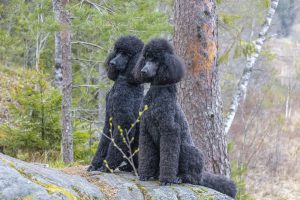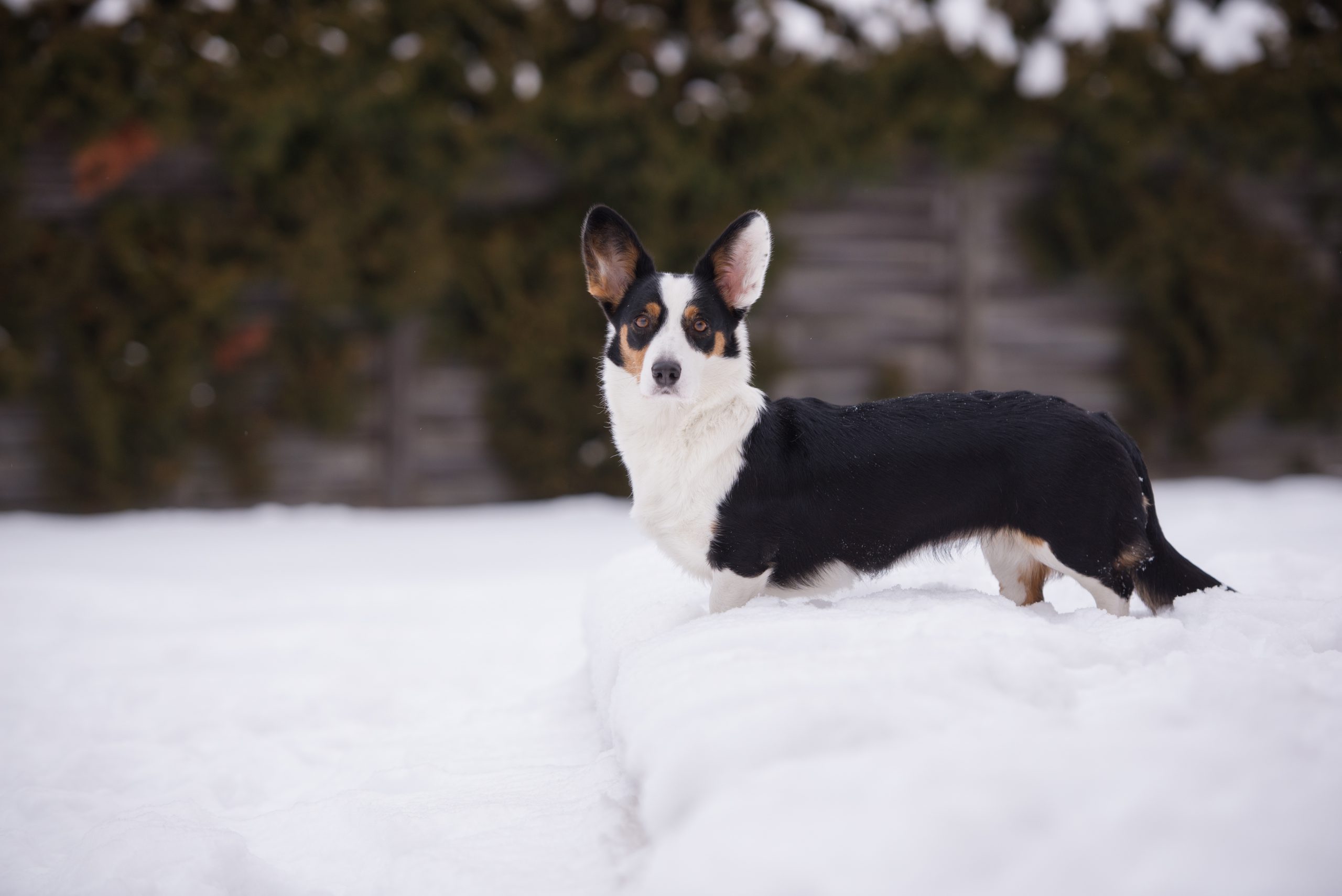
Cardigan Welsh Corgi preliminary summary
The Cardigan Welsh Corgi community recently received the preliminary analysis of the biodiversity of their breed by submitting 35 Cardigan Welsh Corgi to UC Davis for analysis. As a result, Dr Felipe Avila has created the initial report. Click here to add your Cardigan Welsh Corgi to the population in our database!
How inbred is the typical Cardigan Welsh Corgi?
First off, let’s talk a little about what the researchers at UC Davis are looking at in the report. One aspect of the UC Davis canine diversity test is a calculation that estimates how inbred a dog is. This estimate, called Internal Relatedness or IR, is a number between -1 and 1. When a dog is more inbred, the number will between 0 and 1; the closer to 1 the more inbred the dog. When a dog is more outbred, the number will be between -1 and 0; the more negative the number the more outbred the dog.
An outbred puppy has inherited markers from its sire that were very different from those it inherited from its dam; the parents of this puppy would be considered unrelated. An inbred puppy would inherit many of exact same markers from both dam and sire; the parents of this puppy would be considered more closely related to one another. Being outbred reduces the likelihood of known and unidentified recessive component diseases expressing in individuals. When dogs in a breed are, on average, more outbred, the natural healthy genetic variation in the breed is more easily preserved. When dogs in a breed are, on average, more inbred, the natural healthy genetic variation in the breed is more quickly lost, or bred out. This latter deterioration of genetic diversity of a breed, or biodiversity (described simply below), should be the aim of all preservation breeders to avoid in order to maintain their breeds for the future.
Having discussed what the numbers mean above, how inbred or outbred are the individuals in the Cardigan Welsh Corgi breed?
From the report:
One-half of the Cardigan Welsh Corgis assessed in this study had IR scores equal to or greater than 0.028 and 25% of the dogs had IR scores of 0.1 or greater. This means that this cohort is comprised of a very small group of inbred dogs (IR>0.25) which is balanced by a group of strongly outbred dogs (IR scores ranging from -0.21 to -0.06).
Dr. Felipe Avila
For perspective, the statement above is very typical for purebred populations, in fact, often more of the population is inbred. This means many of the parents of these tested dogs were likely as unrelated as possible within the context of this gene pool. Breeders of these dogs have mostly been diligent in selecting complementary mates that are less or unrelated whenever possible.
While it is clear Cardigan Welsh Corgi breeders have done a good job creating outbred puppies, it’s far easier to know whether dogs are unrelated for the breed when they are genetically tested rather than looking through very deep pedigrees or using pedigree-based calculations. Additionally, breeders can better assess how close a linebreeding may actually be, as well as whether or not an imported dog is actually an outcross for their breeding program. Breeders can benefit from predictive software that will ease the difficulty of selecting unrelated breeding mates. This would ensure that future breedings are not too close, which would risk health as a result and hasten the loss of healthy variation in the breed. (Remember, though, it’s not just about inbreeding. )
After assessing this population based on a randomly bred “ideal” population of Southeast Asian village dogs, Dr. Avila noted, “the curve representing IRVD scores for the 35 Cardigan Welsh Corgis (blue line) is shifted to the right of their actual IR scores (red line). Almost one-half of this cohort have IRVD values of 0.25 or greater (Table 4, Figure 4), which means that if they were found among village dogs, they would all be considered offspring of at least full sibling parents.“. Therefore, if we looked at the tested Cardigan Welsh Corgi as if they were village dogs, they would appear much more inbred when compared to their population. This analysis indicates the gene pool, while well managed, is quite small and likely had a bottleneck event, which is why, when compared to the canine population with ideal diversity, they appear to be so closely related. Let’s take a closer look at the genetic diversity, or biodiversity, of the Cardigan Welsh Corgi breed below.
How much biodiversity exists in the Cardigan Welsh Corgi today?
Dr. Avila analyzes the data collected from the VGL canine diversity test in different ways in order to assess the total amount of biodiversity within each breed. Many of these measures together give us an overall picture of the state of the breed and as a result we can make informed decisions on breed management.
The best explanation I’ve yet read is from BetterBred Founder Natalie, and as a result we will share it again here!
Most breeders think of DNA as coming in two options- a good gene, or a mutant gene – like it is in many DNA tests. In fact, there can be many versions of each gene or (in this case) marker in a single place on the DNA – like a t-shirt that is available in different colors. The more variants there are, the more information we have about the population genetics of a breed. In more inbred breeds, there are fewer variants for each marker. So to use our analogy, an inbred breed might have only a few colors available in t-shirts, whereas a diverse breed will have t-shirts in many colors. Apart from the relatively small number of genes that make up specific, visible breed traits, the rest of the gene pool is generally healthier when there’s a lot of variation for each marker.
Unfortunately when breeders select too strictly for too long and for very specific traits, there can be an unintended loss of variation in the parts of the DNA that thrive with more variation. A good way to assess whether that good variation has been impacted is by using the markers found in the VGL canine diversity test. Because they are considered neutral – or not associated with any specific known trait – they are great for assessing genetic diversity. In breeds with ample diversity, there will be lots of variations for each marker (lots of colors in the t-shirt drawer.)
But what if you have a breed without much variation? Well, this happens, and can happen quite often. In this case the best thing breeders can do is try to make sure the variants that are in the breed are well distributed – so there are plenty of all of them in the breed. Imagine a t-shirt drawer with lots and lots of red t-shirts but only one blue t-shirt and one green t-shirt. If you lose one of the red ones, it doesn’t change much about the t-shirt drawer – there are lots of other red ones. But if you lose either the blue or green one, the variation is seriously diminished. If, on the other hand a third of the shirts are red, and a third are green and a third are blue, then it’s a lot harder to lose the existing variation in the drawer, even if you lose one once in a while, and even though there are only 3 colors.
The Cardigan Welsh Corgi’s biodiversity
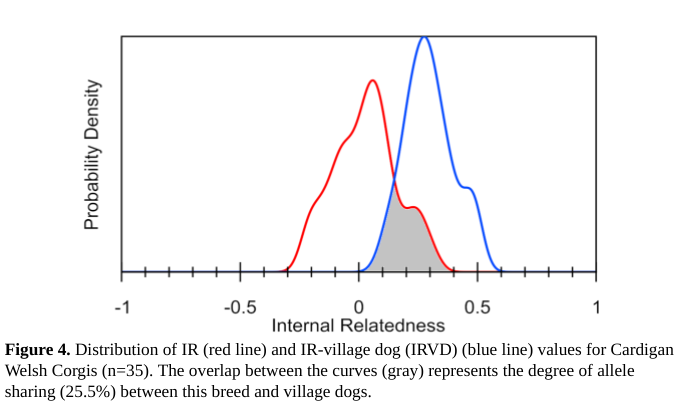
We discussed the individual dogs’ inbreeding levels within the Cargian Welsh Corgi population above. However, when we look at the inbreeding level of all individuals in the breed in aggregate – meaning the whole breed altogether- we can gather more information about the breed as a whole. When a whole breed is very inbred on the same few ancestors, it can result in very little remaining biodiversity within the breed. Therefore when the researchers consider their inbreeding as though they were a part of a population of village dogs (often considered “ideal” for biodiversity because they have retained all the genetic variation found now in modern breeds combined, and more), researchers can estimate the amount of biodiversity remaining in a modern breed compared to all the diversity that once existed in dogs prior to breed formation.
So when this investigation was done for Cardigan Welsh Corgi, what did Dr. Avila find?
The gray area in Figure 4 represents the overlap between IR and IRVD curves (25.5%), which is an estimate of the amount of genetic diversity in present-day randomly breeding village dogs that still exists in contemporary Cardigan Welsh Corgis. This amount of genetic diversity is similar to the retained genetic diversity (25%) found in all canids tested at the VGL to date (section IIB).
Dr. Felipe Avila
This assessment indicates that there has been a depletion of genetic diversity in this breed compared to the “ideal”, but let’s look at the data another way:
A secondary way to estimate the loss of biodiversity, due to breed formation and breeding choices post-formation, is to look at the average number of alleles found at each tested locus and to compare those to the other breeds tested to date by UC Davis.
So, if we look at these numbers what do we find out about this population?
The most noticeable aspect of allelic diversity in the Cardigan Welsh Corgi is the relatively low number of alleles found at each locus compared to more popular breeds. This number ranged from 3 (INU055, LEI004, and VGL2009) to 8 (AHT121, VGL0760) alleles per locus in the study cohort. Contrary to other pure dog breeds in which one allele predominates at each locus, Cardigan Welsh Corgi showed more evenly distributed allelic frequencies for the 33 autosomal STR loci.
Dr. Felipe Avila
…
The average number of alleles (Na) identified in this cohort was low, representing approximately 35% of alleles known to exist at each of these loci in all canids tested at the VGL (5.39 out of 15.4). This number is similar to that of breeds with low genetic diversity such as the Bernese Mountain Dog (36%), American Eskimo Dog (36%) and Flat-Coated Retriever (35%).
This number predicts that the Cardigan Welsh Corgi has retained 35% of the existing biodiversity available to canids; this number is much higher than the estimate from the IRVD, which estimated a retention of 25% of existing biodiversity. This can be explained because all purebred canids have lost some biodiversity, whereas Southeast Asian village dogs are likely to have conserved most of the biodiversity that existed in the species.
When looking at the number of alleles found, we consider two things here at BetterBred: the average number of alleles found in total (Na), and the average effective alleles per locus (Ne). The average number of effective alleles are the ones that are effectively contributing to the heterozygosity of a breed. Going back to the t-shirt analogy above, say we have 10 t-shirts, and 8 of them are red and one is green and one is yellow. The total number of shirt colors essentially 3, however the majority color is red, therefore our “effective” t-shirt color would essentially only be 1.
The average alleles per locus in this population was found to be 5.3 (Na). However, Ne (average effective alleles per locus) is a much more telling number, as this is the amount of markers that are effectively contributing to the population’s heterozygosity. This number is currently only 3.1 (Ne). Therefore, this report discovered that the breed is on average only effectively using about 58.4% of it’s total available biodiversity (Ne/Na). It is possible that this number will increase (or decrease) with more of the population sampled; however, we have found that the health of breeds tends to correlate with how high the Ne/Na ratio is for each breed. This ratio in Cardigan Welsh Corgis is a great goal for any breed to obtain.
How does a breed community increase the Ne or average effective alleles per locus? They identify individuals who may have unusual genetics for the population, and work to preserve those genetics and redistribute them in the population at large.
Breed relationships
Another use of the data from the VGL canine diversity test is to see how the individuals within the population fit in relation to one another. What do we see when we look at this analysis, called the PCoA graph?
Some of the individuals clustered together (red circles) which suggests that they are more closely related to each other than the cohort at large. Conversely, a few dogs appeared as outliers from the main population, seen as isolated dots on the periphery of the PCoA. Overall, this cohort is comprised of individuals as unrelated as possible and is likely to represent the genetic diversity of the breed as a whole.
Dr. Felipe Avila
Figure 3 shows the pattern of clustering of Cardigan Welsh Corgis
Dr. Felipe Avila
from the US (orange dots) versus non-US dogs (blue dots) – Australia, New Zealand, and
Denmark. Since the PCoA graph displays the degree of genetic differentiation between
individuals, the more distant two points (representing dogs) are from each other, the greater the
genetic differences between them. This analysis shows an overall tendency of the different
populations of Cardigan Welsh Corgis (US vs. non-US) to cluster as genetically distinct varieties,
represented by the orange group towards the right of the graph and the blue group towards the left
quadrants. However, a few dogs cluster away from their main group and blend into the opposite
variety, thus indicating a certain degree of interrelatedness among US and non-US Cardigan Welsh
Corgis.
Unlike many other breeds analyzed, it appears that there is some degree of separation genetically in the breed due to geographic location. This means that often (though not always) importing a dog may offer different genetic variety to breeders from what is currently in the region.
The immune system
The UC Davis VGL canine diversity test can identify more regions of the DLA than any other test available today. The Dog Leukocyte Antigen, called the DLA, is the region of the DNA that codes for the immune system in the dog. There are three regions, Class I, Class II and Class III. This test identifies both Class I and II haplotypes. (A haplotype is a tightly linked group of genes within an organism that is inherited as a group from a single parent.) To learn more about the DLA, read here.
From the report:
Seven DLA class I and seven DLA class II haplotypes were identified in this study cohort (Table 5). DLA1 haplotype 1045 was the most frequent, being identified in 37% of the dogs tested; the most frequent DLA2 haplotype was 2039 (36% frequency). The remaining DLA1 and DLA2 haplotypes were identified at lower frequencies in the population. Together, the frequencies of DLA1 haplotypes 1045 and 1012 (24%), and DLA2 haplotypes 2039 and 2003 (24%) were disproportionately high, occurring in over 60% of dogs tested.
….
Dr. Avila
The DLA class I and II regions are frequently shared among breeds, reflecting common distant ancestry and inheritance by descent. DLA haplotype analysis showed extensive DLA I and DLA II haplotype sharing with 42 other dog breeds (Table 6). Interestingly, the predominant DLA I haplotype 1045 (37%) and DLA II haplotype 2039 (36%) were also the most frequent in the Collie (95% and 95%, respectively) and in the Scottish Collie (71.8% and 71.3%, respectively). This corroborates they shared distant ancestry. None of the DLA haplotypes identified in the Cardigan Welsh Corgi were exclusive to the breed.
In summary on the DLA: The Cardigan Welsh Corgi have a low amount of variation in the DLA in comparison to other breeds. However, like many other dog breeds, there are 1-2 DLA haplotypes that are found more frequently than the other DLA haplotypes sampled. Haplotype 1045 paired with 2039 is carried by a large proportion of this population, while the other haplotypes are far less well represented. This distribution can be improved by selecting mates with atypical DLA haplotypes and breeding pairs with different Class I/ Class II extended haplotypes. More haplotypes may be found as more Cardigan Welsh Corgis are tested.
Conclusions
Based on this report, the Cardigan Welsh Corgi breeders have been doing a good job creating outbred puppies; however, the breed has average to below average biodiversity. It will be of great importance to conserve the existing biodiversity so further depletion does not occur due to random loss of alleles – called genetic drift. Breeders can do this by testing their dogs and placing a priority on breeding dogs with less well represented genetics in comparison to the rest of the population, provided they are good, healthy examples of the breed. Using BetterBred’s tools designed to identify these individuals, Average Genetic Relatedness (AGR) and the Outlier Index (OI), breeders can assess these dogs for selection as mates, as well as simulate what to expect in potential litters. Special attention might be warranted to preserve the less typical DLA haplotypes so they are not lost to genetic drift.
Do you own a Cardigan Welsh Corgi and want to add them to the population? Click here to add your Cardigan Welsh Corgi to the study!
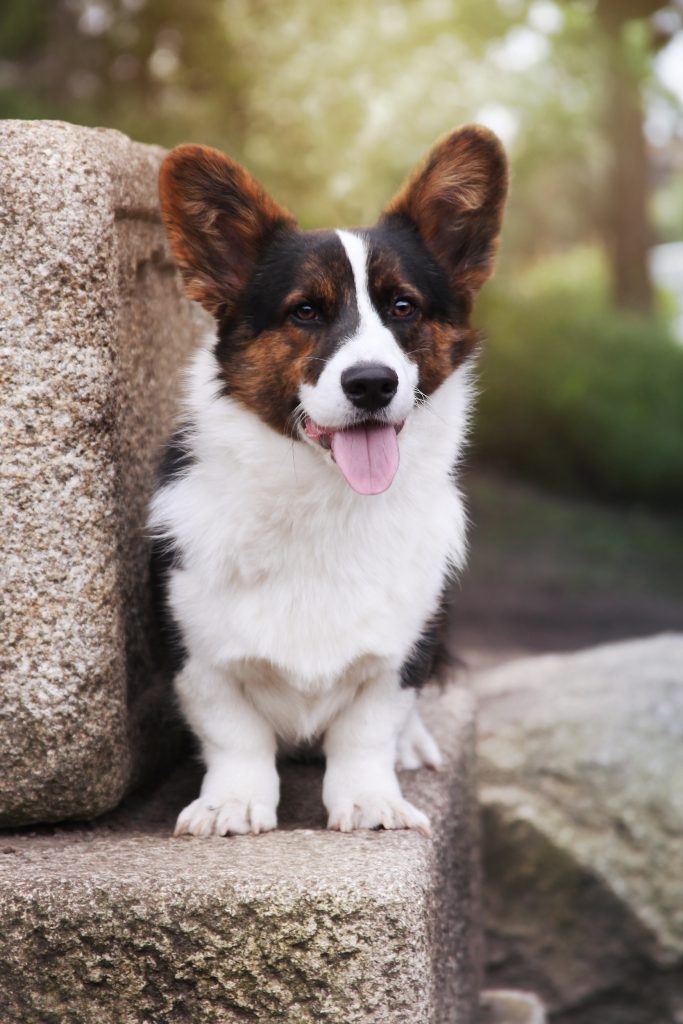

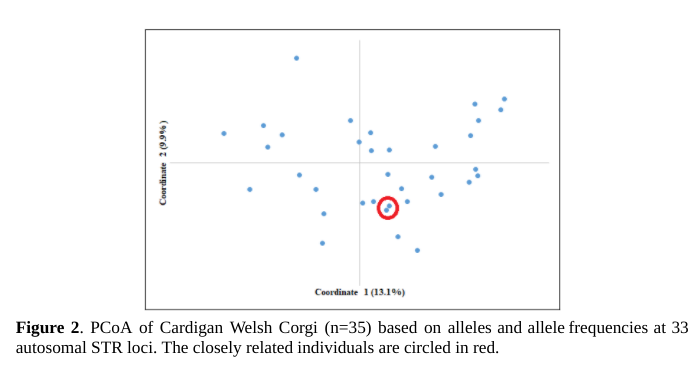
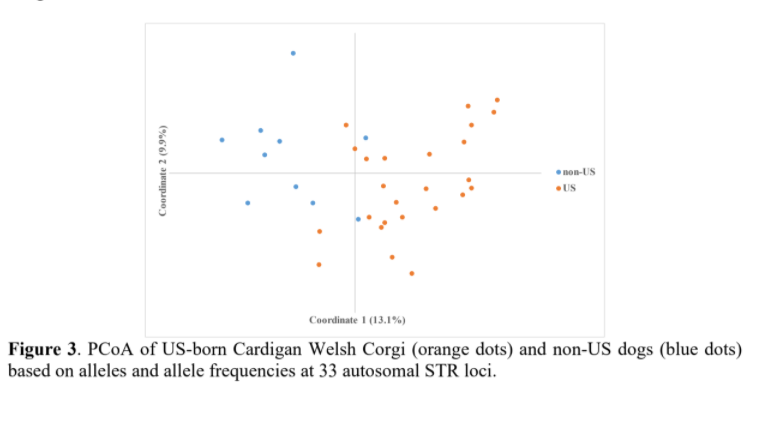
 Previous Post
Previous Post Next Post
Next Post


